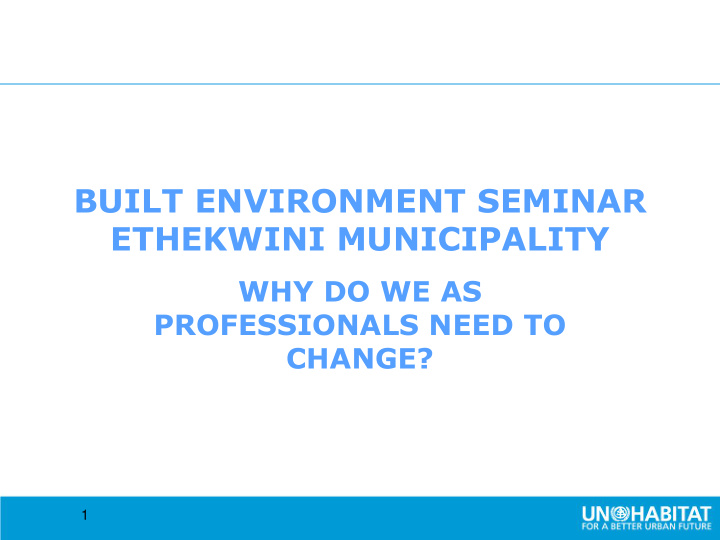



BUILT ENVIRONMENT SEMINAR ETHEKWINI MUNICIPALITY WHY DO WE AS PROFESSIONALS NEED TO CHANGE? 1
Background: 20 th Century Failures of Planning Business As Usual Vs Sustainable Urban Development Urban Sprawl -> Compactness Segregation -> Integration Congestion -> Connectivity
CONTEXT : MAJOR GLOBAL CHALLENGES • Global urban population : 50% in 2007 70% by 2050 • Sanders; “Arrival City”: end 21 st century as a wholly urban species • Social inclusion – The number of slum dwellers world – wide is expected to increase from 1 billion to 2 billion over next 25 years • Economic growth : Cities produce up to 80% of national wealth; cities key to addressing economic growth; • Environmental concerns inc food security urban growth eroding food production land by 20km 2 per day globally 3
2. Principles and Practices
Structure of the Guidelines Promote key Urban and Territorial Planning (UTP) principles organised along 4 main pillars: A A. URBAN POLICY AND GOVERNANCE B1 B3 B. UTP FOR SUSTAINABLE DEVELOPMENT B2 B1 UTP and Social Development B2 UTP and Sustained Economic Growth B3 UTP and the Environment C D C. UTP COMPONENTS D. IMPLEMENTATION AND MONITORING OF UTP Action-oriented recommendations for four stakeholders groups (national governments, local authorities, CSOs & planning professionals) along the multiscale continuum of spatial planning
THE IG-UTP AND NEW URBAN AGENDA • The New Urban Agenda adopted HABITAT III • Many commitments requiring action by member states' National Government – 165 paragraphs • Strong synergy with IG-UTP • IG – UTP = “National Governments should ...”
NUA AND IG-UTP EXAMPLES OF COINCIDENCE Issue Action Clause in NUA IG – UTP 1.National Develop and implement Urban National Urban Policies Clause 12 20 a & 41 Policies Enabling policy frameworks Clause 76 20b Participatory urban policies Clause 80 & 38 20b ICT policies Clause 146 30 e 3. Integrated planning Reinvigorate integrated urban and territorial planning Clause 12 & 82 26 & 36 a Access to infrastructure Clause 31 (37 f = LA) Partnerships, Social Inclusion Clause 33,58, and participatory processes 86, 93 & 144 20 b & 27 b Quality public spaces Clause 34 & 94 33 7
Way forward • We have to switch from the what to the how: lot of time spent on “what” should be done - now time to focus on doing and thinking “how” . • More is not enough: inefficiencies in previous efforts around urban development. More of what we are already doing will not be enough. Have to reconsider the way we are working and find alternative patterns for collaborating in more inclusive and efficient ways. 8
PROFESSIONALISM vs ADMINISTRATION • Traditional professions are all changing • Clear shift in role from technical expert to enabler • Requires less thinking technically and greater thinking critically • We need to address spatial justice, human rights, social inclusion, the urban – rural continuum, partnerships and no more thinking in silos • Needs professional judgement and no “tick a box” administrator / clerical thinking 9
A simple number can mean something 10
Thinking out of the box – what does this mean? 11
WHAT IS THIS ? 12
WHAT IS DENSITY ???? 13
14
CONCLUSIONS We are at a Galilean moment. The Earth is not flat. It is urban” “We Urbanism” and concludes with this wonderful statement: “We are at a Galilean moment. The Earth is not flat. It is “We (Michael Cohen, New School, New are at a Galilean moment. The Earth is not flat. It is urban” (Michael York Cohen, New School, New York) urban” (page 21) are at a Galilean moment. The Earth is not flat. It is urban” (page 21) 15
Recommend
More recommend